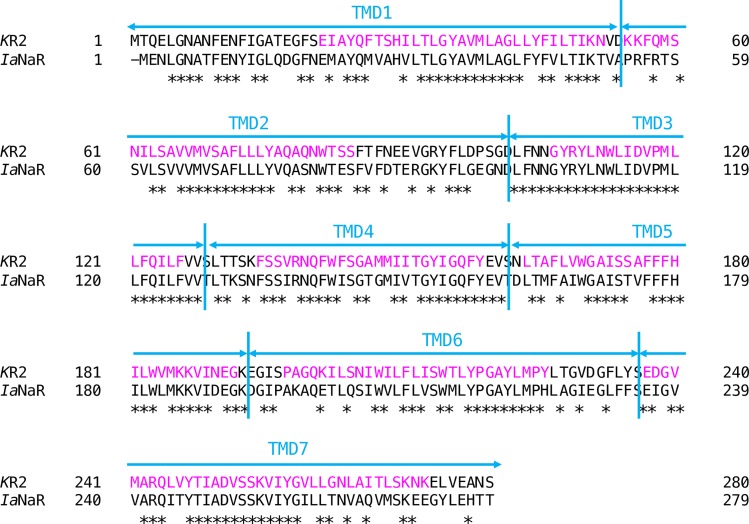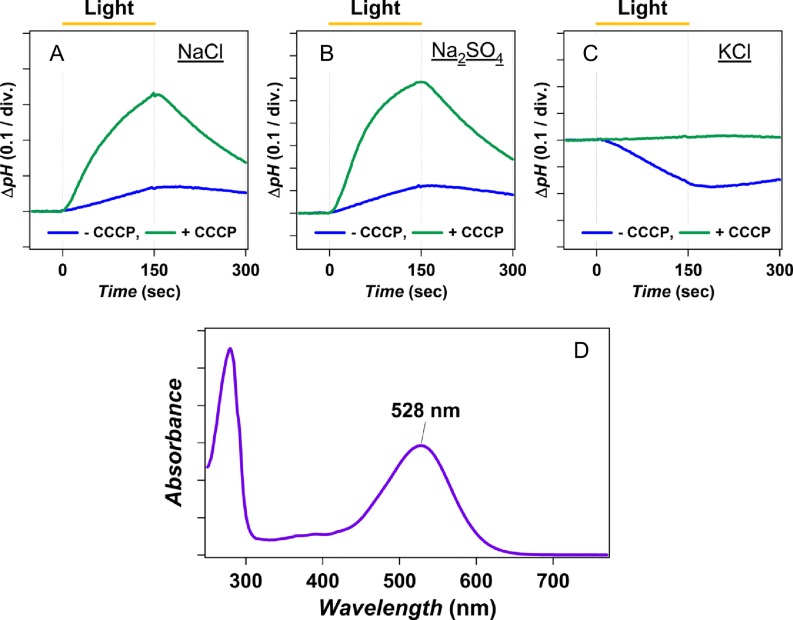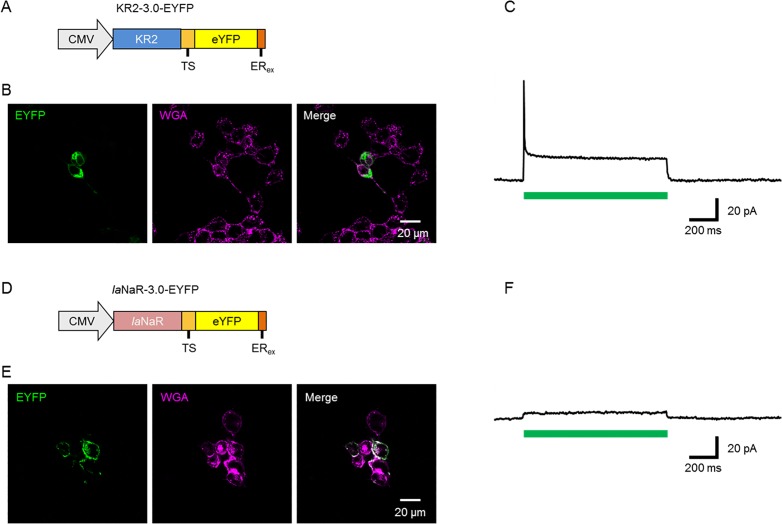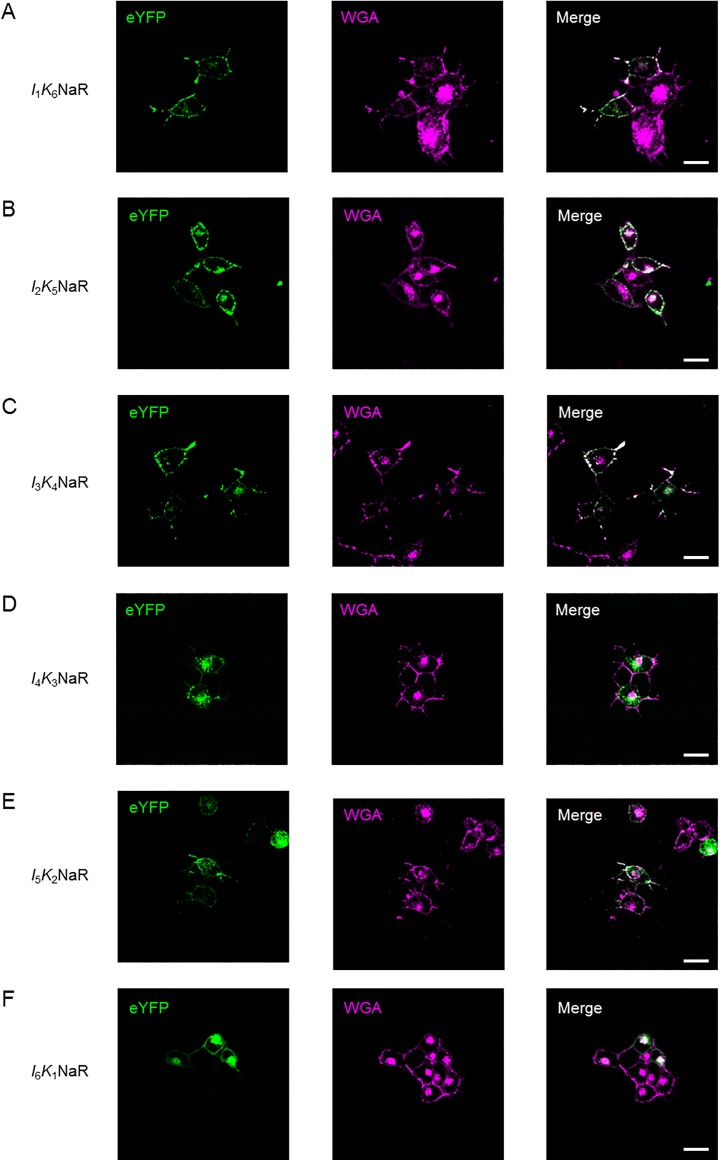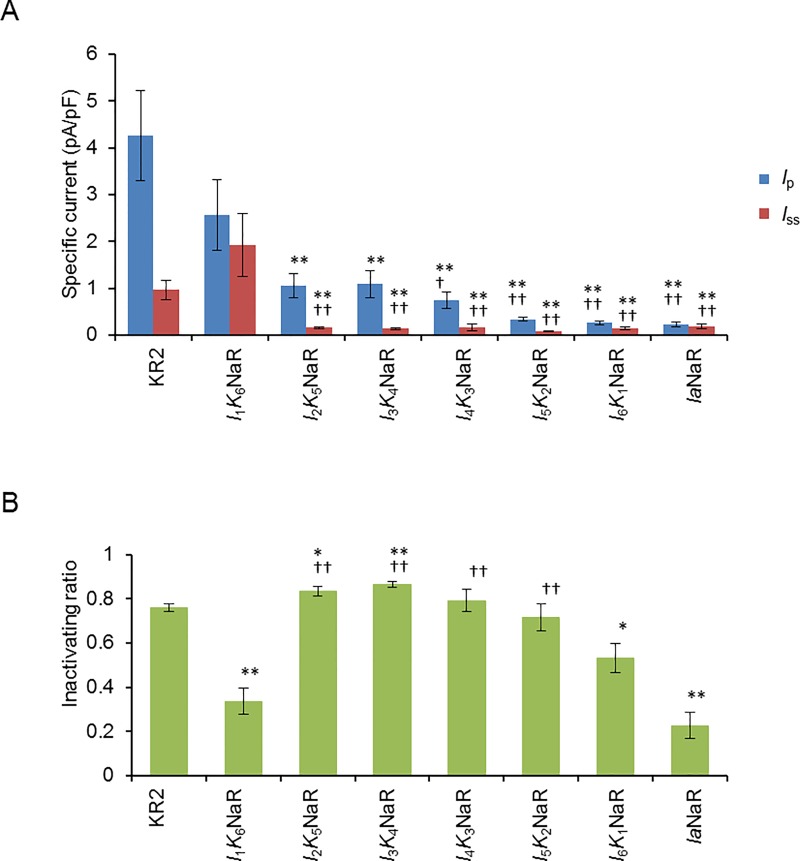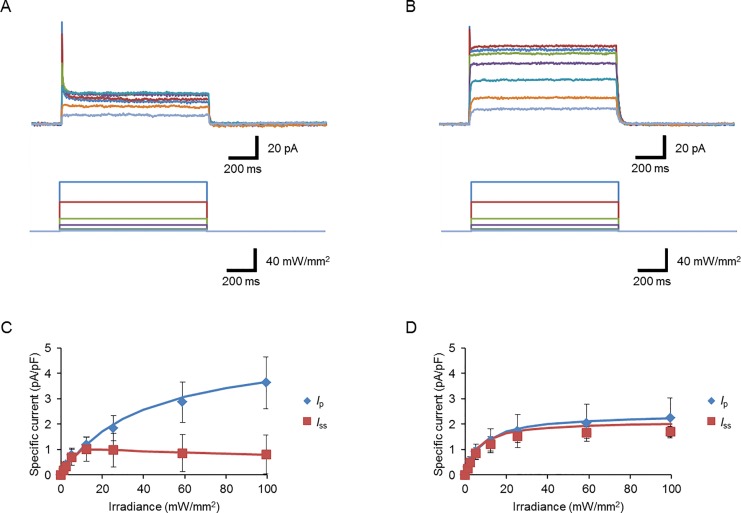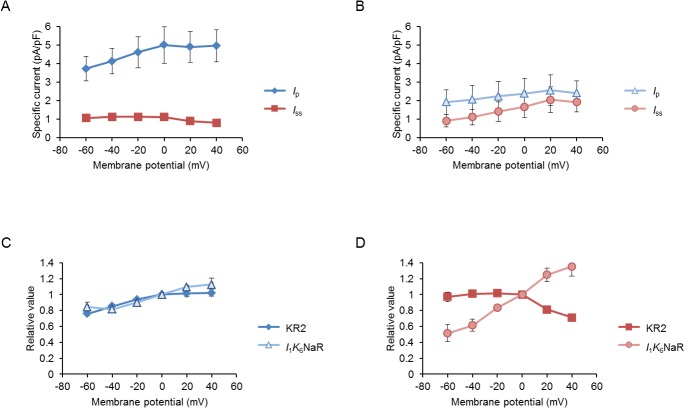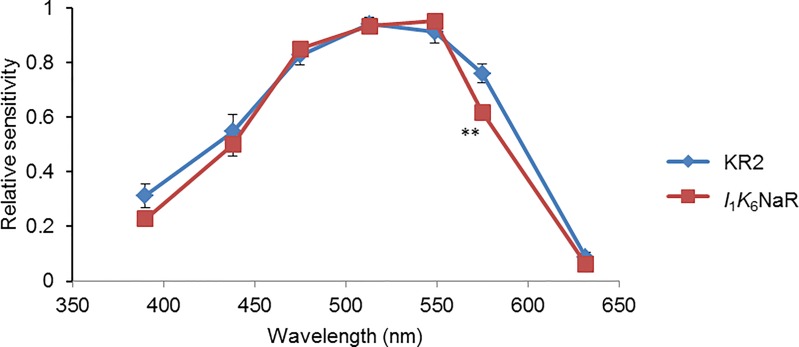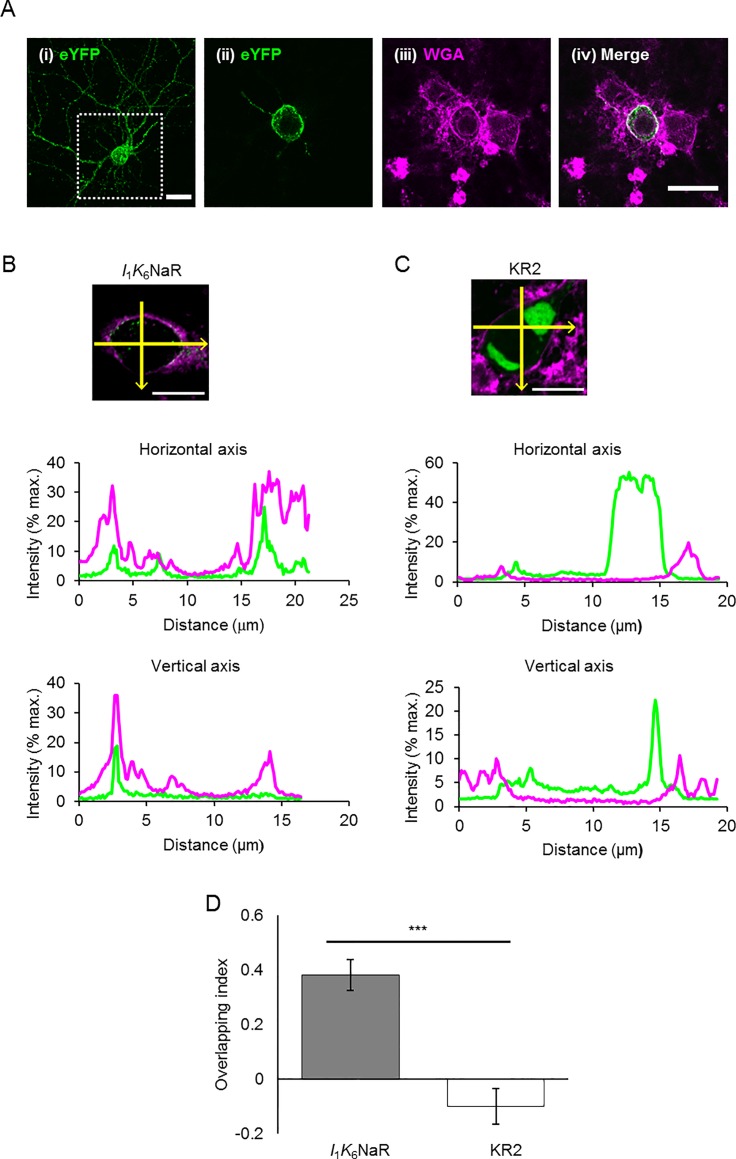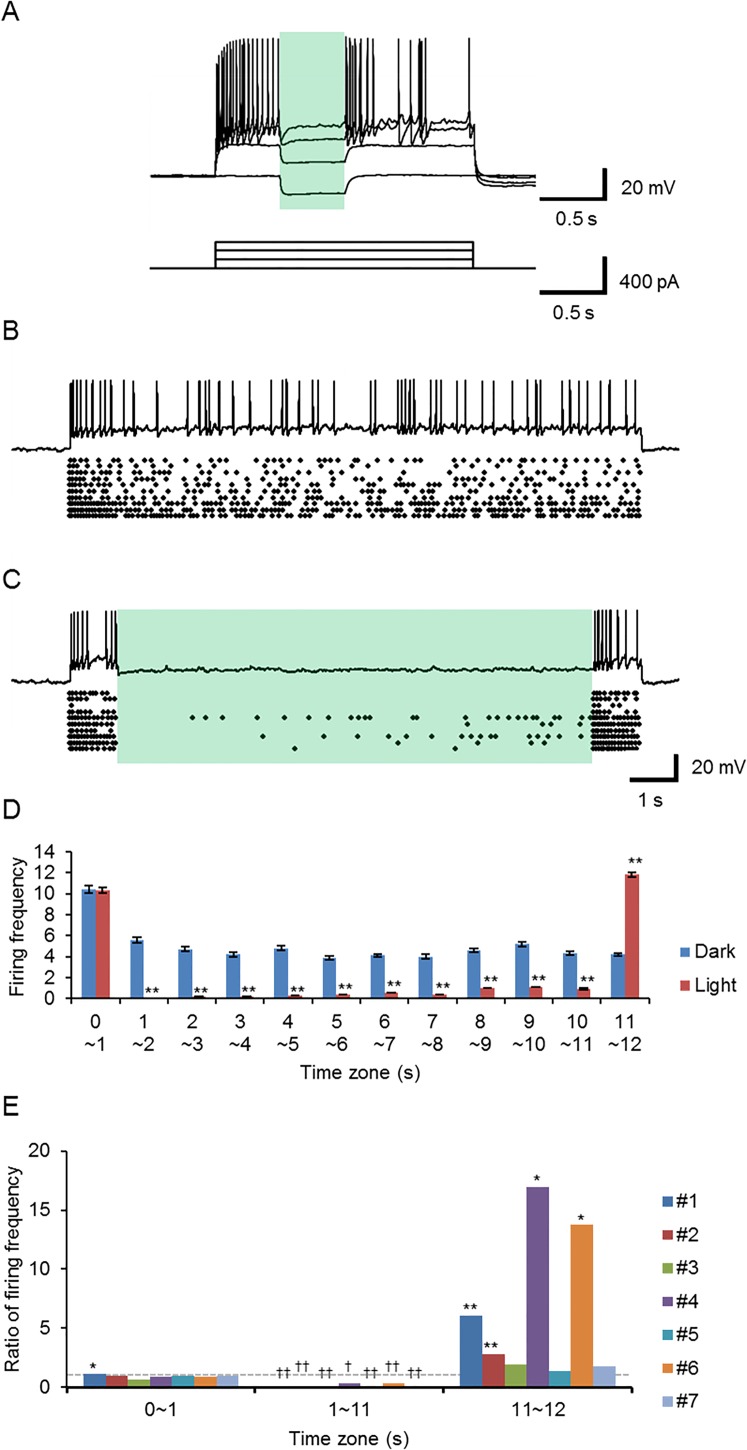Abstract
With the progress of optogenetics, the activities of genetically identified neurons can be optically silenced to determine whether the neurons in question are necessary for the network performance of the behavioral expression. This logical induction is expected to be improved by the application of the Na+ pump rhodopsins (NaRs), which hyperpolarize the membrane potential with negligible influence on the ionic/pH balance. Here, we made several chimeric NaRs between two NaRs, KR2 and IaNaR from Krokinobacter eikastus and Indibacter alkaliphilus, respectively. We found that one of these chimeras, named I1K6NaR, exhibited some improvements in the membrane targeting and photocurrent properties over native NaRs. The I1K6NaR-expressing cortical neurons were stably silenced by green light irradiation for a certain long duration. With its rapid kinetics and voltage dependency, the photoactivation of I1K6NaR would specifically counteract the generation of action potentials with less hyperpolarization of the neuronal membrane potential than KR2.
Introduction
A neural system is a kind of computing system comprised by a vast number of neurons. Understanding of the significance of a neuron or a set of neurons in a network has been one of the major goals of neuroscience. In recent years the optical methods have been developed to manipulate genetically targeted neurons using light under precise spatiotemporal resolution [1–4]. For example, the neuronal excitability is enhanced by light if light-sensitive cation channels such as channelrhodopsin-2 (ChR2) are expressed in a neuron [5,6]. The resulting neural network or behavior responses suggest that the stimulated neuron is involved in the responses as a sufficient condition, although it is necessary to avoid oversimplification [4]. On the other hand, optical silencing of the neural activity could determine whether the neuron in question is necessary for the network performance of the behavioral expression.
In the field of the optogenetics, the microbial Cl--pump rhodopsins such as a halorhodopsin from Natronomonas pharaonis (NpHR) and the microbial H+-pump rhodopsins such as archaerhodopsins from Halorubrum sodomense (AR3/ArchT) are now the most widely used loss-of-function tools, which effectively hyperpolarize the membrane potential to inhibit the generation of action potentials [7–11]. Recently, Cl-/anion channel rhodopsins have become another potential candidates for the purpose of optogenetic silencing of the neural activities [12–15]. Although they have made great progress, these tools still have some disadvantages such as inevitable changes in the ionic/pH balance between the intracellular and extracellular milieu [1,16,17]. In addition, in the case of Cl-/anion channel rhodopsins, the direction of the membrane potential change should be dependent on the Cl--equilibrium potential, which can be affected by many factors such as development, localization and disease [18–25]. On the other hand, a new microbial rhodopsin named KR2 from the marine flavobacterium Krokinobacter eikastus, was characterized as one of the light-driven Na+ pumps that transport Na+ from the inside to the outside of the expressed cell under physiological conditions [26]. As the natural excitatory signals generally induce Na+ influx through non-selective cation channels, the Na+ pump rhodopsins (NaRs) are ideal tools to reduce the neuronal excitability by light, but with minimal influence on the ionic/pH balance [27].
Recently the numbers of NaRs are increasing to form a large subfamily of microbial rhodopsins [28]. Here, we characterized one of the microbial rhodopsins named IaNaR from Indibacter alkaliphilus as a new NaR that transports Na+ from the inside to the outside of the expressed cell under physiological conditions. The ion-transporting activity of IaNaR was inefficient when exogenously expressed in mammalian cells. However, one of the chimeric NaRs between IaNaR and KR2 exhibited some improvements in the membrane targeting and photocurrent properties over native ones. It is anticipated that the chimeric NaRs will become useful to counteract the generation of action potentials when expressed in neurons as an optogenetic silencing tool.
Materials and Methods
Protein expression and purification
The synthesized IaNaR gene, whose codons were optimized for E. coli expression, was inserted into the Nde I-Xho I site of pET21a vector, with the resulting construct encoding a His6 tag at the C-terminus. The expression plasmid of IaNaR was transformed in to E. coli C41(DE3) and the rhodopsins were overexpressed in the cells induced with 1 mM isopropyl-β-D-thiogalactopyranoside (IPTG) and 10 μM all-trans retinal for 4 hours. The crude membrane was solubilized with 1.5% n-dodecyl-β-D-maltoside (DDM), and the solubilized fraction was purified by TALON Metal Affinity Resin (Clontech Laboratories Inc., Mountain View, CA, USA).
Measurement of ion-transport activity
The IaNaR expressing cells were collected by centrifugation (4,800×g, 2 min), washed three times and resuspended in the same solvent (in mM), 100 NaCl, 100 Na2SO4 or 100 KCl, as for ion-transport measurement. The cell suspension was placed in the dark and then illuminated by using a 1-kW tungsten-halogen projector lamp (Master HILUX-HR, Rikagaku, Japan) through a glass filter (Y-52, AGC Techno Glass, Japan) for 2.5 min at wavelengths > 500 nm. The light-induced pH changes during incubation were monitored with a pH meter (F-55, Horiba, Japan).
Molecular biology
The CMV promoter-based expression plasmids encoding KR2, IaNaR, or its chimeras fused in-frame with a membrane trafficking signal (TS), an enhanced yellow fluorescent protein (eYFP), and an ER export signal (ERex) were prepared as previously reported [27]. Both TS and ERex were derived from a Kir2.1 potassium channel with amino acid sequences of “N-KSRITSEGEYIPLDQIDINV-C (20 amino acids)” and “N-FCYENEV-COOH (7 amino acids)”, respectively [29]. The cDNAs encoding chimeras between E. coli codon-optimized IaNaR and human codon-optimized KR2 were prepared using In-Fusion cloning technology (Takara Bio, Shiga, Japan). Briefly, the amino acid sequences of the apoprotein were divided into seven transmembrane domains (TMDs) so that each TMD contained a transmembrane helix. These segments are referred to (from N-terminal to C-terminal) as “TMD1”, “TMD2”, “TMD3”, “TMD4”, “TMD5”, “TMD6”, and “TMD7” (Fig 1). The N-terminal transmembrane domains (TMDs) of KR2 were replaced in order with the homologous counterparts of IaNaR and thus we prepared 6 chimeras; I1K6NaR from TM1 (Met1-Val52) of IaNaR and TM2-7 (Asp54-Ser280) of KR2, I2K5NaR from TM1-2 (Met1-Asn100) of IaNaR and TM3-7 (Asp102-Ser280) of KR2, I3K4NaR from TM1-3 (Met1-Val127) of IaNaR and TM4-7 (Ser129-Ser280) of KR2, I4K3NaR from TM1-4 (Met1-Val160) of IaNaR and TM5-7 (Ser162-Ser280) of KR2, I5K2NaR from TM1-5 (Met1-Lys192) of IaNaR and TM6-7 (Glu194-Ser280) of KR2 and I6K1NaR from TM1-6 (Met1-Phe234) of IaNaR and TM7 (Ser236-Ser280) of KR2. For optimal expression in cultured neurons, the CMV enhancer/promoter was replaced with the CaMKIIα promoter. All constructs were verified by sequencing.
Fig 1. Primary structure of the Na+ pump rhodopsin (NaR) apoproteins.
The sequence alignment of two NaRs, one from Krokinobacter eikastus (KR2, amino acids 1–280) and the other from Indibacter alkaliphilus (IaNaR, amino acids 1–279) is shown. Identical amino acids are indicated by an asterisk. The seven transmembrane helixes of KR2 (Kato et al., 2015) are lettered in magenta. The amino acid sequences of the apoprotein were divided into seven transmembrane domains (TMDs) so that each TMD contain a transmembrane helix (cyan vertical lines). These segments are referred to (from the N-terminal to C-terminal) as “TMD1”, “TMD2”, “TMD3”, “TMD4”, “TMD5”, “TMD6”, and “TMD7”, respectively.
All constructs were verified by sequencing, and submitted to DDBJ/EMBL/GenBank (http://www.ddbj.nig.ac.jp/index-e.html) with accession codes in the parentheses; human codon-optimized KR2 (Acc# LC012789), E. coli codon-optimized IaNaR (Acc# LC187664), I1K6NaR (Acc# LC187665), I2K5NaR (Acc# LC187666), I3K4NaR (Acc# LC187667), I4K3NaR (Acc# LC187668), I5K2NaR (Acc# LC187669) and I6K1NaR (Acc# LC187670),
Mammalian cell culture
The electrophysiological assays of NaRs were made using ND7/23 cells as described previously [30]. Briefly, the cells were grown in Dulbecco’s modified Eagle’s medium (Wako, Osaka, Japan) supplemented with 2.5 μM all-trans retinal, 10% fetal bovine serum under a 5% CO2 atmosphere at 37°C. The expression plasmid encoding KR2, IaNaR, or its chimeras was transiently transfected in ND7/23 cells using Effectene Transfection Reagent (Qiagen, Tokyo, Japan) according to the manufacturer’s instructions. Electrophysiological recordings were then conducted 20–48 h after the transfection. Successfully transfected cells were identified by the presence of eYFP fluorescence.
Under anesthesia with a mixture (1 ml/kgBW) of ketamine (50 mg/ml, Daiichi Sankyo Co. Ltd., Tokyo, Japan) and xylazine (xylazine hydrochloride, 10 mg/ml, Sigma-Aldrich, St. Louis, MO, USA), the cortical neurons were isolated from embryonic day 16 Wistar rats (Japan SLC Inc., Shizuoka, Japan), using Nerve-Cells Dispersion Solutions (Wako) according to the manufacturer’s instructions, and were grown in neuronal culture medium (Wako) under a 5% CO2 atmosphere at 37°C. The neuronal expression plasmids were transiently transfected into cortical neurons by calcium phosphate transfection at days in vitro (DIV) 5 or 6. Electrophysiological recordings were then conducted at DIV 22–25 with neurons identified as expressing eYFP fluorescence by a conventional epifluorescence system.
All animal experiments were approved by the Tohoku University Committee for Animal Experiments (Approval No. 2014LsA-001) and were carried out in accordance with the Guidelines for Animal Experiments and Related Activities of Tohoku University as well as the guiding principles of the Physiological Society of Japan and the National institutes of health (NIH), USA. The number of animals in this study was kept to a minimum and, when possible, all animals were ketamine- xylazine anesthetized to minimize suffering.
Electrophysiology
All experiments were carried out at room temperature (23 ± 2°C). Photocurrents were recorded as previously described [30] using an EPC-8 amplifier (HEKA Electronic, Lambrecht, Germany) under a whole-cell patch clamp configuration. The data were filtered at 1 kHz and sampled at 10 kHz (Digidata1440 A/D, Molecular Devices Co., Sunnyvale, CA) and stored in a computer (pClamp10.3, Molecular Devices). The photocurrent peak and steady-state (at the end of a 1-s light pulse) amplitudes were expressed as effective values (Ip and Iss, respectively) after being divided by the whole-cell capacitance, which is proportional to the cell’s surface area. For evaluating the magnitude of inactivation, the difference between Ip and Iss was divided by Ip.
The internal pipette solutions for the whole-cell voltage clamp recordings from the ND7/23 cells contained (in mM): 20 NaOH, 100 L-glutamic acid Na salt, 5 EGTA, 50 HEPES, 2.5 MgCl2, 2.5 MgATP, 0.1 leupeptin and pH 7.3 (adjusted by HCl). The cells were continuously superfused at a rate of 2 mL/min by ACSF solution (in mM): 125 NaCl, 2.5 KCl, 25 NaHCO3, 1.25 NaH2PO4, 2 CaCl2, 1 MgCl2, 11 glucose, pH 7.4 and equilibrated with 95% O2 and 5% CO2.
The internal pipette solution for the whole-cell current-clamp recordings from cortical neurons contained (in mM): 125 K-gluconate, 10 NaCl, 0.2 EGTA, 10 HEPES, 1 MgCl2, 3 MgATP, 0.3 Na2GTP, 10 Na2-phosphocreatine, 0.1 leupeptin and pH 7.4 adjusted with KOH. The cells were continuously superfused at a rate of 2 mL/min by ACSF solution equilibrated with 95% O2 and 5% CO2. In all cortical neuron experiments, the ACSF contained 100 μM picrotoxin (Nacalai Tesque, Kyoto, Japan) and 1 mM kynurenic acid (Sigma-Aldrich Co. LLC, St Louis, MS., USA) to block all synaptic inputs. The directly measured liquid junction potential was 11.4 mV and was compensated for.
Optics
Irradiation was performed using a SpectraX light engine (wavelength > 90% of the maximum, 534–600 nm, Lumencor Inc., Beaverton, Oregon, USA) controlled by computer software (pCLAMP10.3, Molecular Devices). The power density (irradiance) of the light was directly measured under microscopy by a visible light-sensing thermopile (MIR-101Q, SSC Co., Ltd., Kuwana City, Japan) and was 99 mW/mm2. To investigate the action spectrum, irradiation was made at wavelengths (nm, >90% of the maximum, irradiance): 390 ± 18 (3.4 mW/mm2), 438 ± 24 (3.0 mW/mm2), 475 ± 28 (2.7 mW/mm2), 513 ± 17 (2.7 mW/mm2), 549 ± 15 (2.6 mW/mm2), 575 ± 25 (2.8 mW/mm2) and 632 ± 22 (2.8 mW/mm2).
Cytochemistry
Live cultured cells were reacted with 2 μg/ml of wheat germ agglutinin (WGA) conjugated with Alexa Fluor 633 (W21404, Thermo Fisher Scientific, Waltham, MA, USA) for 10 min at 37°C, then fixed with 4% paraformaldehyde. Localization was assessed by confocal microscopy (LSM710, Carl Zeiss, Oberkochen, Germany) equipped with ×63 oil objective lens. For the detection of each fluorescence substrate, the following optical combinations were used: a 488 nm argon laser and 523–620 nm bandpass filter for eYFP, a 633 nm HeNe laser and 638–747 nm bandpass filter for WGA.
For images of primary cultured cortical neurons, each pixel value of the relative fluorescent intensity was profiled along horizontal/vertical axes, which were delineated to pass the centroid of the cell (Zen software, Carl Zeiss), and the cross-correlation analysis between eYFP fluorescence and WGA florescence (Alexa Fluor 633) was performed for the pixel values between two points that were outside of the membrane to reach half of the peak amplitude of the WGA fluorescence (Clampfit 10, Molecular Devices). The overlapping index of a cell was defined as the average of 14 cross-correlation coefficients calculated for each lag of 0, ±1, ±2 and ±3 (the maximal distance, ±0.4 μm) along the horizontal and vertical axes. It was expected to be +1.0 when both profiles between eYFP and WGA are completely overlapped and to be -1.0 when there was no overlap.
Statistical analysis
All data in the text, figures and tables are expressed as mean ± SEM and were evaluated with the Mann-Whitney U-test for statistical significance unless otherwise noted. It was judged as statistically insignificant when P > 0.05.
Results
Characterization of IaNaR
Fig 1 shows the sequence of IaNaR aligned with the sequences of KR2, another NaR from marine flavobacterium. They were 86% homologous and consisted of 7 domains with each transmembrane helix (TMD1-7).
To study the ion-transport selectivity of IaNaR, the protein was expressed in E. coli cells and the light-induced pH change was monitored upon illumination of the cell suspension. Fig 2A shows the light-induced pH change of the cell suspension in 100 mM NaCl. We observed an increase in pH (Fig 2A, blue line) that was enhanced by the addition of carbonylcyanide-m-chlorophenylhydrazone (CCCP) (Fig 2A, green line). This result indicates that the increase in pH represents the secondary H+-uptake into the E. coli cell body to compensate the hyperpolarized membrane potential generated by the transport of ions other than H+ by IaNaR. In order to reveal the type of ion transported by IaNaR, we investigated the cation and anion dependencies. In 100 mM Na2SO4, an increase in the pH identical to the result with NaCl was observed (Fig 2B). Thus, the transport of IaNaR does not depend on the type of anion in the suspension. By contrast, a decrease in pH was observed in the suspension containing 100 mM KCl (Fig 2C). Because it diminished with the addition of CCCP (Fig 2C, green line), this result shows that IaNaR pumps H+ in the presence of larger cations. This cation dependence of IaNaR is identical to KR2 [26] suggesting that IaNaR is a light-driven Na+ pump as expected from its amino-acid sequence including the characteristic NDQ-motif which is composed of Asn111, Asp115 and Gln122 for IaNaR [26].
Fig 2. Ion-transport activity of IaNaR.
(A-C) Light-induced pH changes upon light-illumination (>500 nm, indicated by yellow lines) of the E. coli cells expressing IaNaR in 100 mM NaCl (A), 100 mM Na2SO4 (B) and 100 mM KCl (C) without (blue lines) and with CCCP (green lines). (D) The UV-visible absorption spectrum of purified IaNaR.
To obtain the absorption spectrum of IaNaR, we purified the protein expressed by E. coli and solubilized in n-dodecyl-β-D-maltoside (DDM). The spectrum of solubilized IaNaR (Fig 2D) showed its absorption maximum at λmax = 528 nm, which is close to that of KR2 (λmax = 524 nm) [26] suggesting that their protein structures should be identical.
The photocurrent properties of IaNaR were compared with KR2 by introducing a KR2 gene or IaNaR gene fused with membrane-trafficking signal (TS), enhanced yellow fluorescent protein (eYFP), and ER-export signal (ERex) [29] into cultured ND7/23 cells, hybrid cell lines derived from neonatal rat dorsal root ganglia neurons fused with mouse neuroblastoma [31]. The constructs were termed KR2-3.0-eYFP and IaNaR-3.0-eYFP, respectively (Fig 3A and 3D). As shown in Fig 3B, the eYFP fluorescence was frequently found in the inclusion bodies in the KR2-expressing cells, suggesting the accumulation of misfolded/mistargeted proteins. However, every expressing cell responded to green-yellow light (534–600 nm, 99 mW/mm2) robustly with an outward photocurrent under a whole-cell clamp at a holding potential of 0 mV (Fig 3C). The KR2 photocurrent was rapidly activated to form a peak current (Ip, 4.26 ± 0.97 pA/pF, n = 10), inactivated to form a steady-state current (Iss, 0.96 ± 0.20 pA/pF, n = 10) and deactivated to the baseline. As ND7/23 cells were live cell-stained with fluorescent WGA, the white merge indicated that the IaNaR was mostly expressed in the membrane (Fig 3E). However, its photocurrent generated by green-yellow light (534–600 nm, 99 mWmm-2) was significantly smaller than that of KR2 for both Ip (0.22 ± 0.05 pA/pF, n = 10) and Iss (0.19 ± 0.05 pA/pF, n = 10) (P < 0.005, Mann-Whitney U-test) (Fig 3F). Therefore, KR2 appears to be advantageous for optogenetic applications with larger photocurrent whereas IaNaR is suitable for the exogenous expression with better membrane-targeting.
Fig 3. NaR expression in mammalian cells.
(A) The expression plasmid, KR2-3.0-eYFP, consisted of the KR2 gene fused with a 20-amino-acid membrane-trafficking signal (TS), enhanced yellow fluorescent protein (eYFP), and 7-amino-acid ER-export signal (ERex). (B) Expression of KR2-3.0-eYFP in the cultured ND7/23 cells: eYFP fluorescenc (left, green), wheat germ agglutinin (WGA) conjugated with Alexa Fluor 633 (middle, magenta) and the merge (right). (C) Typical photocurrent of KR2. The green bar indicates the period when green-yellow light (534–600 nm, 99 mW/mm2) was irradiated. (D) The expression plasmid, IaNaR2-3.0-eYFP. (E) Expression of IaNaR2-3.0-eYFP in the cultured ND7/23 cells: eYFP fluorescence (left, green), WGA (middle, magenta) and the merge (right). (F) Typical photocurrent of IaNaR. The green bar indicates the period when green-yellow light (534–600 nm, 99 mW/mm2) was irradiated.
Evaluation of chimeric NaRs
The above results suggested the possibility that some chimeric NaRs between KR2 and IaNaR may have the advantages of both NaRs, a larger photocurrent and improved membrane-targeting. To test this, six chimeric NaRs were made by replacing the N-terminal TMDs of KR2 with their counterparts of IaNaR (Fig 1) on the assumption that the N-terminal domains of IaNaR should be involved in the membrane-targeting. Each gene of chimeric NaR: I1K6NaR consisting of TMD1 from IaNaR and TMD2-7 from KR2, I2K5NaR consisting of TMD1-2 from IaNaR and TMD3-7 from KR2, I3K4NaR consisting of TMD1-3 from IaNaR and TMD4-7 from KR2, I4K3NaR consisting of TMD1-4 from IaNaR and TMD5-7 from KR2, I5K2NaR consisting of TMD1-5 from IaNaR and TMD6-7 from KR2 and I6K1NaR consisting of TMD1-6 from IaNaR and TMD7 from KR2, was fused with TS, eYFP and ERex and transfected to ND7/23 cells for the evaluation. Since TMD3 of IaNaR and KR2 are completely identical to each other (Fig 1), I2K5NaR and I3K4NaR were the same in the amino-acid sequence but different as genes in the DNA sequence. As shown in Fig 4, the fluorescence expression of each chimeric NaR was similar to that of IaNaR. Both the Ip and Iss of I1K6NaR were significantly larger than those of the other chimeric NaRs as well as that of IaNaR (Fig 5A). Therefore, I1K6NaR appeared to be a candidate chimeric NaR for optogenetic applications.
Fig 4. Expression of chimeric NaRs in ND7/23 cells.
(A) I1K6NaR: eYFP fluorescence (left), fluorescent wheat germ agglutinin (WGA, middle) and the merge (right). (B)-(F) Similar to (A), but the expression pattern of I2K5NaR, I3K4NaR, I4K3NaR, I5K2NaR, I6K1NaR, respectively. Scale, 20 μm for each.
Fig 5. Photocurrent of chimeric NaRs.
(A) The peak (Ip, blue columns) and the steady-state (Iss, red columns) photocurrent at 0 mV holding potential in response to green-yellow light (534–600 nm, 99 mW/mm2) were compared among KR2 (n = 10), chimeric NaRs: I1K6NaR (n = 11), I2K5NaR (n = 10), I3K4NaR (n = 10), I4K3NaR (n = 10), I5K2NaR (n = 10), I6K1NaR (n = 9) and IaNaR (n = 10). (B) Comparison of the inactivating ratio. The difference was significant when compared to KR2 (*, P < 0.05, **, P < 0.005, Mann-Whitney U-test) or I1K6NaR (†, P < 0.05, ††, P < 0.005, Mann-Whitney U-test).
Next, we compared the photocurrent properties of I1K6NaR with those of KR2 at the maximal irradiance (534–600 nm, 99 mW/mm2) and at a holding potential of 0 mV (Table 1). Similar to IaNaR, the magnitude of inactivation of the I1K6NaR photocurrent was significantly smaller than KR2 (P < 0.005, Mann-Whitney U-test). It was also smaller than those of the other chimeric NaRs (Fig 5B). In the case of KR2, the Ip was monotonically increased with the increase of irradiance, whereas the Iss had a tendency to reach the ceiling at around 20 mW/mm2 and was somewhat reduced with the increase of irradiance (Fig 6A and 6C). On the other hand, both the Ip and Iss approached their ceilings with the increase of irradiance in the case of I1K6NaR (Fig 6B and 6D). The photocurrent-irradiance relationship is expected to follow Michaelis-Menten kinetics as the rhodopsin follows a single-photon photodynamism [32]. The apparent KD of Ip was significantly smaller for I1K6NaR than for KR2 (Table 1, P < 0.05, Mann-Whitney U-test). Although the Iss of I1K6NaR mostly followed the Michaelis-Menten relationship up to 99 mW/mm2, that of KR2 was well fitted to the Michaelis-Menten relationship from which a power-dependent current suppression component above a threshold of 10 mW/mm2 was subtracted. Therefore the KD of Iss was compared by fitting the data of irradiance between 0 and 12 mW/mm2 to the Michaelis-Menten relationship. The KD of Iss was significantly smaller for I1K6NaR than for KR2 (Table 1, P < 0.05, Mann-Whitney U-test).
Table 1. Photocurrent characteristics of KR2 and I1K6NaR.
| KR2 | I1K6NaR | |
|---|---|---|
| Ip [pA/pF] | 4.26 ± 0.97 (n = 10) | **2.57 ± 0.75 (n = 11) |
| Iss [pA/pF] | 0.96 ± 0.20 (n = 10) | **1.92 ± 0.68 (n = 11) |
| Inactivation ratio | 0.76 ± 0.02 (n = 10) | **0.34 ± 0.06 (n = 11) |
| KD (Ip) [mW/mm2] | 39.3 ± 8.3 (n = 8) | *8.3 ± 1.1 (n = 9) |
| KD (Iss) [mW/mm2] | 18.7 ± 4.9 (n = 8) | *6.2 ± 1.4 (n = 9) |
| Sneg (Ip) [103mV-1] | 4.03 ± 0.39 (n = 8) | 2.45 ± 0.90 (n = 7) |
| Sneg (Iss) [103mV-1] | 0.43 ± 1.00 (n = 8) | **7.33 ± 2.13 (n = 7) |
The photocurrents were responses to green-yellow light (534–600 nm) at 99 mW/mm2 except for KD for which the power of light was variable.
*, P < 0.05
**, P < 0.005
Mann-Whitney U-test
Fig 6. Photocurrent properties of I1K6NaR.
(A) Sample photocurrents of KR2 (upper traces) at various powers of light (lower traces). (B) Sample photocurrents of I1K6NaR (upper traces) at various power of light (lower traces). (C) The amplitude of the peak (Ip, blue diamonds) and steady-state (Iss, red squares) of the KR2 photocurrents as functions of irradiance (n = 8). The blue line is drawn according to the Michaelis-Menten relationship, y = 5.12x /(x+39.3). The red line is the Michaelis-Menten relationship from which the power-dependent current suppression component above a threshold of 10 mW/mm2 was subtracted, y = 2.8x/(x+18.7)– 2.3(x-10)/{(x-10)+38.1)}. (D) Similar to (C), but in the case of I1K6NaR photocurrent (n = 9). Each line is drawn according to the Michaelis-Menten relationship, y = 2.4x /(x+8.3) (blue) and, y = 2.1x /(x+6.2) (red), respectively.
The I1K6NaR photocurrent differed from the KR2 photocurrent in the voltage sensitivity (Fig 7A and 7B). When normalized by the value at a holding potential of 0 mV, the Ip current-voltage (I-V) relationship was positively related to the holding potential for both NaRs (Fig 7C). Although the Iss of KR2 was almost insensitive to the holding potential, particularly in the negative region, that of I1K6NaR was positively related to the holding potential (Fig 7D). To further test this, the slope of each normalized I-V relationship was calculated in the negative region of the holding potential (Sneg). As shown in Table 1, the Sneg of I1K6NaR was significantly larger than that of KR2 for Iss (P < 0.005, Mann-Whitney U-test) but not for Ip.
Fig 7. Sensitivity of I1K6NaR photocurrent to the membrane potential.
(A) The current-voltage (I-V) relationship of the peak (Ip, blue diamonds) and steady-state (Iss, red squares) of the KR2 photocurrents (n = 8). (B) The current-voltage (I-V) relationship of peak (Ip, light blue triangles) and steady-state (Iss, light red circles) of I1K6NaR photocurrents (n = 7). (C) Each Ip of KR2 (blue diamond) and I1K6NaR (light blue triangle) was expressed as a relative value to that at 0 mV holding potential and plotted as a function of voltage. (D) Each Iss of KR2 (red square) and I1K6NaR (light red circle) was expressed as a relative value to that at 0 mV holding potential and plotted as a function of voltage.
The Iss at each wavelengths (390, 438, 475, 513, 549, 575 and 632 nm at the center, respectively) was corrected by the irradiance (3.4, 3.0, 2.7, 2.7, 2.6, 2.8 and 2.8 mW/mm2, respectively) and its relative sensitivity to the maximum was averaged for KR2 and I1K6NaR and shown in Fig 8 as a function of the wavelength. Although the spectral sensitivity of the I1K6NaR photocurrent was almost similar to that of KR2, it was significantly lower in response to yellow light (575 nm) (P < 0.005, Mann-Whitney U-test).
Fig 8. Action spectrum of I1K6NaR.
For each wavelength the relative photocurrent amplitude (Iss) was divided by the irradiance, normalized to its maximum and averaged. The photocurrents of KR2 (blue diamonds, n = 9) and I1K6NaR (red squares, n = 12) did not show transient peaks because of the small magnitude of irradiance. **, P < 0.005, Mann-Whitney U-test.
Light-dependent inhibition of neuronal activity
Previously, the light-dependent activation of KR2 effectively silenced the neural activities both in vitro and in vivo. To test the possible application of I1K6NaR as an optogenetic silencer, the light-dependent changes of the membrane potential were investigated in cultured rat cortical neurons expressing I1K6NaR. As shown in Fig 9A, the I1K6NaR fluorescence was localized in the membrane when expressed in the cultured cortical neurons. Quantitative comparisons of the membrane targeting of the eYFP-labeled molecules were made between I1K6NaR and KR2 using primary cultured neurons from the cortex the plasma membrane of which was live cell-stained with a fluorescence marker, Alexa Fluor 633-labeled WGA. For each molecule, 10 neurons were randomly selected and the confocal images of their somas were quantitatively analyzed for localization of the fluorescence; the overlapping index of I1K6NaR was 0.38 ± 0.06 (n = 10) and positive for every neuron (range, 0.11~0.68) (Fig 9B). On the other hand, the overlapping index of KR2 fluorescence was -0.10 ± 0.06 (n = 10), negative in 7 of 10 neurons (range, -0.53~0.24) and significantly smaller than that of I1K6NaR (P < 0.0005, Mann-Whitney U-test) (Fig 9C and 9D).
Fig 9. Quantitative evaluation of membrane targeting of NaRs.
(A) Expression of eYFP-labeled I1K6NaR in the cultured cortical neuron. (i) Integrated confocal image of the neuron (Z-stack projection of 12 slices at every 0.46 μm in depth). (ii) eYFP image of a single slice shown in the dot-lined square in (i). (iii) Image of the fluorescent WGA of the same region. (iv) Merge of (ii) and (iii), indicating the expression of I1K6NaR in the neuronal membrane. (B) Profiling of the fluorescent intensity of an I1K6NaR-expressing neuron. The pixel values along the horizontal/vertical axes, which were delineated to pass the centroid of the cell (yellow), were plotted as functions of distance: eYFP fluorescence (green) and WGA fluorescence (magenta). The overlapping index was 0.68. (C) Profiling of the fluorescent intensity for a KR2-expressing neuron. The overlapping index was -0.21. (D) Comparison of the overlapping index between I1K6NaR (left) and KR2 (right). ***, P < 0.0005, Mann-Whitney U-test. Scales, 20 μm for (A) and 10 μm for (B) and (C).
Under current clamp, the resting membrane potentials (RMPs) were between -51 and -83 mV (-64 ± 4 mV, n = 11) and hyperpolarized by 8–24 mV (-15 ± 5 mV, n = 11) with light (549 nm, 2.6 mW/mm2). Although action potentials were repetitively generated by the depolarization through current injection, they were hardly evoked during irradiation of light (Fig 10A). In every experiment (n = 11), the action potentials, evoked once, were reversibly inhibited during irradiation (549 nm, 2.6 mW/mm2). The light-induced inhibition of firing was quite stable and remained effective for as long as 10 s (Fig 10B–10D). In summary of 7 similar experiments (Fig 10E), the firing frequency was significantly smaller throughout the irradiation period (10 s, 549 nm, 2.6 mW/mm2) than the corresponding period in the darkness (P < 0.05, Wilcoxon signed rank test). The firing frequency was often increased when the irradiation was turned off (rebound potentiation, Fig 10C and 10D). Indeed, a significant increase of firing frequency was observed in 4 of 7 similar experiments (Fig 10E).
Fig 10. Light-dependent silencing of the neuronal activity.
(A) Series of sample records of the membrane potentials of an I1K6NaR-expressing neuron under current clamp (top traces, RMP, -76 mV). The depolarization was made through current injection (bottom traces). The green light (549 nm, 2.6 mW/mm2) hyperpolarized the membrane potential and suppressed the generation of action potentials. (B) Generation of repetitive action poteintals in an I1K6NaR-expressing neuron under current clamp (top trace, RMP, -73 mV). The responses to 10 repetitive depolarizations are summarized as raster plots of the action potentials (bottom). (C) The activity of the same neuron was stably silenced during the green light irradiation (549 nm, 2.6 mW/mm2) for 10 s (top trace, RMP, -73 mV). The responses to 10 repetitive depolarizations are summarized as raster plots of action potentials (bottom). (D) The firing frequencies during time zones of 1 s each. The effects of green light irradiation (time zones from 2~11 s) were compared for the same neuron shown in (A) and (B); without (‘Dark’ protocol, blue columns) and with light (‘Light’ protocol, red columns). Note the significant increase of firing frequency at the off period (time zone 11~12 s). (E) Ratios of firing frequency of ‘Light’ to ‘Dark’ protocol during time zone 0~1 s (before irradiation), 1~11 s (during irradiation), 11~12 s (after irradiation), respectively for each neuron #1~7 expressing I1K6NaR (experimental order). The gray dotted line indicate that the ratio = 1. *, P < 0.05; **, P < 0.005; Mann-Whitney U-test applied to the set of records. †, P < 0.05; ††, P < 0.005; Wilcoxon signed rank test applied to the firing frequency for time zone, 1~2, 2~3, 3~4, 4~5, 5~6, 6~7, 7~8, 8~9, 9~10 and 10~11, respectively.
Discussion
This study addressed the question whether a new Na+-pump rhodopsin from Indibacter alkaliphilus (IaNaR) could serve as an optogenetic silencer with negligible disturbance of the ionic milieu both inside and outside of the membrane [27]. The ion-transport assay with E. coli cells showed that IaNaR outwardly transports Na+ when the internal solution contained Na+, but H+ when all the Na+ was replaced by K+. This ion-transporting property and selectivity is identical to KR2, the first reported NaR [26], and NaR from Dokdonia sp. PRO95 [33]. λmax of IaNaR (528 nm) is also similar to KR2 (524 nm) [26] and NaR from Dokdonia sp. PRO95. (523 nm) [33]. Therefore, the fundamental properties of IaNaR including the ion-transporting function and the structure around retinal are similar of those of previously reported NaRs. When IaNaR was expressed in the mammalian cells such as ND7/23, its photocurrent was very small even under the maximal power of green-yellow light (534–600 nm, 99 mW/mm2). However, it appeared to be better targeted to the plasma membrane than KR2.
The eYFP-labeled KR2 molecules frequently accumulated in large intracellular compartments even after the gene was fused with a TS and an ERex which facilitates the plasma membrane expression of the transcribed rhodopsins [29]. The exogenously expressed membrane proteins are often misfolded resulting in the ER retention or degradation with a reduction of functional membrane proteins at their correct sites [34]. The accumulation of misfolded proteins also causes ER stress, which can lead to cell death if remains unmitigated [35,36]. It is possible that IaNaR could provide conformations that help the rhodopsin to become folded correctly and to be targeted to the plasma membrane with minimal ER stress. Indeed, the chimera rhodopsins consisting of the N-terminal TMDs from IaNaR and the C-terminal TMDs of KR2 appeared to be well targeted to the plasma membrane rather than in the intracellular compartments of ND7/23 cells. Among the chimeras, I1K6NaR consisting of TMD1 from IaNaR and TMD2-7 from KR2 generated Ip and Iss as large as KR2. However, it remains puzzling that the magnitude of the photocurrent of IaNaR and some of its chimeric derivatives was similar to or lower than that of KR2 even with the improved membrane targeting. The possibility that the ion-transporting efficiency of IaNaR and its derivatives is lower than that of KR2 should be investigated in future. Alternatively, the membrane-targeted molecules may be relatively rapidly internalized and/or denatured in the case of IaNaR and its derivatives. Further modification of molecules, focusing on the N-terminal extracellular segment and TM1, might create an NaR with larger photocurrent amplitude and better membrane targeting [37–39].
Similar to KR2, the ion-transport assay with E. coli cells showed that I1K6NaR outwardly transports Na+ when the internal solution contained Na+, but H+ when all Na+ was replaced by K+ (S1 Fig). However, the photocurrent properties of I1K6NaR were somewhat different from those of KR2. Although the difference was insignificant, the Iss of I1K6NaR was relatively large but with a significantly smaller inactivation ratio. The I1K6NaR was significantly more sensitive to light (534–600 nm) than KR2 in both Ip and Iss. As the spectral sensitivity of I1K6NaR was similar to KR2, the different sensitivity may be attributed to the probability of conformational changes at the molecular level upon light absorption. Although KR2 photocurrent was almost insensitive to voltage in both Ip and Iss as reported previously [27], the Iss of I1K6NaR was positively related to the voltage. These photocurrent properties as well as its membrane-targeting trait would suggest that I1K6NaR could become one of the optogenetic NaRs for long-term silencing of neural activities with relatively low power of light.
Upon the cessation of light exposure, the rapid recovery of the membrane potential was often accompanied by the rebound potentiation with the possible changes in the membrane properties during hyperpolarization: the reduced inactivation of voltage-dependent Na+ channels, the deactivation of voltage-dependent K+ channels, and the activation of HCN channels (Ih). Indeed, the NaR-dependent neural silencing was often accompanied by an increase in the firing frequency upon termination of light pulse. Although NpHR and AR3/ArchT are widely-used optogenetic tools for neural silencing, they still have much room for improvement. For example, several papers reported that NpHR triggers artificial neural spiking relatively long after turning-off the light [40–42]. As intracellular Cl- accumulation would inevitably accompany the positive shift of the Cl--equilibrium potential, it is reasonable to assume that the Cl- pumping activity of NpHR enhances the magnitude and duration of the rebound potentiation. In addition, this Cl- accumulation may not be a trivial problem in some cases, such as in vivo optogenetic analysis of mammalian neurons during developmental stages. In adult mammals, the intracellular Cl- concentration is maintained at a low level by several transporters, such as KCC2. However, in developmental stages, when the Cl- extrusion system is still immature, the intracellular Cl- concentration is relatively high with depolarized Cl- equilibrium potential [43,44]. Similarly, it is assumed that the intracellular Cl- accumulation by the activity of the light-driven Cl- pump further enhances the magnitude and duration of the rebound potentiation with repetitive firing, and makes it difficult to infer the functions of target neurons and neural circuits in the behavioral response [45]. In the case of AR3/ArchT, the light-dependent change of local pH around the neurons can activate the proton-gated cation channel such as ASIC (acid sensing ion channel) and cause unintentional rebound potentiation [46]. The AR3/ArchT-dependent intracellular alkalization may lead to the unintentional release of neurotransmitter through triggering Ca2+ influx [47]. Similar cautions will be necessary in the case of light-gated Cl-/anion channels [12–15] as the direction of membrane potential change is dependent on the equilibrium potential of Cl- that can be affected by many factors such as development, localization and disease [18–25]. Distinct from the Cl-/anion channel rhodopsins, the hyperpolarization of the membrane potential is always expected for any NaR because of the unidirectional transport of Na+. Indeed the I1K6NaR-expressing cortical neurons were stably silenced by green light irradiation for a rather long duration. In addition, the artefactual change of the pH balance is expected to be almost negligible as the H+-transporting rate is estimated to be less than 3% those of Na+. This estimation based on the higher Na+ activity than H+ (320,000-fold) inside a mammalian cell in a physiological condition such as 10 mM Na+ and pH 7.3, whereas the rate constant of H+ uptake was larger than that of Na+ uptake with a ratio of 8,000–9000 [48]. Furthermore, one of the marked advantages of I1K6NaR is its I-V relationship: the photocurrent is smaller at the resting membrane potential while larger at the depolarized potential. Under the current-clamp condition, the outward transport of Na+ by the irradiated I1K6NaR is increased by the depolarization before generation of the action potential. As a result, the action potential is inhibited and the membrane potential is hyperpolarized, which on the other hand, decreases the outward Na+ flow. Therefore, with its rapid kinetics, the photoactivation of I1K6NaR could become an ideal optogenetic silencer that specifically suppresses the generation of action potentials with less hyperpolarization of the neuronal membrane potential than KR2. Since the rebound potentiation is dependent on the magnitude of the hyperpolarization and on the duration, its magnitude is expected to be less for I1K6NaR.
Conclusions
We found that one of the chimeras between KR2 and IaNaR, named I1K6NaR, exhibited some improvements in membrane targeting and photocurrent properties over native NaRs. The I1K6NaR would be a potential candidate of the effective optogenetic neural silencer with minimal influence on the ionic/pH balance.
Supporting Information
(a-c) Light-induced pH changes upon light-illumination (>500 nm, indicated by yellow lines) on the E. coli cells expressing I1K6NaR in 100 mM NaCl (a), 100 mM Na2SO4 (b) and 100 mM KCl (c) without (blue lines) and with CCCP (green lines).
(PDF)
Acknowledgments
We thank S. Hososhima for technical instruction and B. Bell for language assistance.
Data Availability
All relevant data are within the paper and its Supporting Information files.
Funding Statement
This study was supported by a Grant-in-Aid for Scientific Research (No. 25250001 to HY and No. 25290002 to TI) from the Ministry of Education, Culture, Sports, Science and Technology (MEXT) of Japan: http://www.jsps.go.jp/english/e-grants/grants01.html, a Grant-in-Aid for Scientific Research on Innovative Areas “Adaptive Circuit Shift” (No. 15H01413 to HY) of the Ministry of Education, Culture, Sports, Science and Technology (MEXT) of Japan: http://www.jsps.go.jp/english/e-grants/grants01.html, a Grant-in-Aid for challenging Exploratory Research (No. 15K15025 to HY), MEXT, Japan: http://www.jsps.go.jp/english/egrants/grants01.html and JST, Strategic International Collaborative Research Program, SICORP.
References
- 1.Yizhar O, Fenno LE, Davidson TJ, Mogri M, Deisseroth K. Optogenetics in neural systems. Neuron 2011;71:9–34. 10.1016/j.neuron.2011.06.004 [DOI] [PubMed] [Google Scholar]
- 2.Yawo H, Asano T, Sakai S, Ishizuka T. Optogenetic manipulation of neural and non-neural functions. Dev Growth Diff. 2013;55:474–490. 10.1111/dgd.12053 [DOI] [PubMed] [Google Scholar]
- 3.Deisseroth K. Optogenetics: 10 years of microbial opsins in neuroscience. Nat Neurosci. 2015;18:1213–1225. 10.1038/nn.4091 [DOI] [PMC free article] [PubMed] [Google Scholar]
- 4.Yawo H, Egawa R, Hososhima S, Wen L. Chaptor 8. General description: Future prospects of optogenetics In Yawo H, Kandori H, Koizumi A, editors. Optogenetics: Light-Sensing Proteins and Their Applications. Tokyo: Springer; 2015. pp. 111–132. [Google Scholar]
- 5.Boyden ES, Zhang F, Bamberg E, Nagel G, Deisseroth K. Millisecond-timescale, genetically targeted optical control of neural activity. Nat Neurosci. 2005;8:1263–1268. 10.1038/nn1525 [DOI] [PubMed] [Google Scholar]
- 6.Ishizuka T, Kakuda M, Araki R, Yawo H. Kinetic evaluation of photosensitivity in genetically engineered neurons expressing green algae light-gated channels. Neurosci Res. 2006;54:85–94. 10.1016/j.neures.2005.10.009 [DOI] [PubMed] [Google Scholar]
- 7.Zhang F, Wang LP, Brauner M, Liewald JF, Kay K, Watzke N, et al. Multimodal fast optical interrogation of neural circuitry. Nature. 2007;446:633–639. 10.1038/nature05744 [DOI] [PubMed] [Google Scholar]
- 8.Han X, Boyden ES. Multiple-color optical activation, silencing, and desynchronization of neural activity, with single-spike temporal resosution. PLoS ONE. 2007;2:e299 10.1371/journal.pone.0000299 [DOI] [PMC free article] [PubMed] [Google Scholar]
- 9.Chow BY, Han X, Dobry AS, Qian S, Chuong AS, Li M, et al. High-performance genetically targetable optical neural silencing by light-driven proton pump. Nature. 2010;46:98–102. doi: 10.1038/nature08652 [DOI] [PMC free article] [PubMed] [Google Scholar]
- 10.Han X, Chow BY, Zhou H, Klapoetke NC, Chuong A, Rajimehr R, et al. A high-light sensitivity optical neural silencer: development and application to optogenetic control of non-human primate cortex. Front Sys Neurosci. 2011;5:00018 10.3389/fnsys.2011.00018 [DOI] [PMC free article] [PubMed] [Google Scholar]
- 11.Zhang F, Vieroch J, Yizhar O, Fenno LE, Tsunoda S, Kianianmomeni A, et al. The microbial opsin family of optogenetic tools. Cell. 2011;147:1446–1457. 10.1016/j.cell.2011.12.004 [DOI] [PMC free article] [PubMed] [Google Scholar]
- 12.Wietek J, Wiegert JS, Adeishvili N, Schneider F, Watanabe H, Tsunoda SP, et al. Conversion of channelrhodopsin into a light-gated chloride channel. Science. 2014;344:409–412. 10.1126/science.1249375 [DOI] [PubMed] [Google Scholar]
- 13.Berndt A, Lee SY, Ramakrishnan C, Deisseroth K. Structure-guided transformation of channelrhodopsin into a light-activated chloride channel. Science. 2014:344:420–424. 10.1126/science.1252367 [DOI] [PMC free article] [PubMed] [Google Scholar]
- 14.Govorunova EG, Sineshchekov OA, Janz R, Liu X, Spudich JL. Natural light-gated anion channels: A family of microbial rhodopsins for advanced optogenetics. Science. 2015;349:647–650. 10.1126/science.aaa7484 [DOI] [PMC free article] [PubMed] [Google Scholar]
- 15.Berndt A, Lee SY, Wietek J, Ramakrishnan C, Steinberg EE, Rashid AJ, et al. Structural foundations of optogenetics: Determinants of channelrhodopsin ion selectivity. Proc Natl Acad Sci USA. 2016;113:822–829. 10.1073/pnas.1523341113 [DOI] [PMC free article] [PubMed] [Google Scholar]
- 16.Beppu K, Sasaki T, Tanaka KF, Yamanaka A, Fukazawa Y, Shigemoto R, et al. Optogenetic countering of glial acidosis suppresses glial glutamate release and ischemic brain damage. Neuron. 2014;81:314–320. 10.1016/j.neuron.2013.11.011 [DOI] [PubMed] [Google Scholar]
- 17.Alfonsa H, Merricks EM, Codadu NK, Cunningham MO, Deisseroth K, Racca C, et al. The contribution of raised intraneuronal chloride to epileptic network activity. J Neurosci. 2015;35:7715–7726. 10.1523/JNEUROSCI.4105-14.2015 [DOI] [PMC free article] [PubMed] [Google Scholar]
- 18.Ben-Ari Y. Excitatory actions of gaba during development: the nature of the nurture. Nat Rev Neurosci. 2002;3:728–739. 10.1038/nrn920 [DOI] [PubMed] [Google Scholar]
- 19.Ben-Ari Y, Gaiarsa J-L, Tyzio R, Khazipov R. GABA: a pioneer transmitter that excites immature neurons and generates primitive oscillations. Physiol Rev. 2007;87:1215–1284. 10.1152/physrev.00017.2006 [DOI] [PubMed] [Google Scholar]
- 20.Szabadics J, Varga C, Molnár G, Oláh S, Barzó P, Tamás G. Excitatory effect of GABAergic axo-axonic cells in cortical microcircuits. Science. 2006;311:233–5. 10.1126/science.1121325 [DOI] [PubMed] [Google Scholar]
- 21.Glykys J, Dzhala V, Egawa K, Balena T, Saponjian Y, Kuchibhotla KV, et al. Local impermeant anions establish the neuronal chloride concentration. Science. 2014;343:670–675. 10.1126/science.1245423 [DOI] [PMC free article] [PubMed] [Google Scholar]
- 22.Kaila K, Ruusuvuori E, Seja P, Voipio J, Puskarjov M. GABA actions and ionic plasticity in epilepsy. Curr Opin Neurobiol. 2014;26:34–41. 10.1016/j.conb.2013.11.004 [DOI] [PubMed] [Google Scholar]
- 23.Pond BB, Berglund K, Kuner T, Feng G, Augustine GJ, Schwartz-Bloom RD. The chloride transporter Na+-K+-Cl- cotransporter isoform-1 contributes to intracellular chloride increases after in vitro ischemia. J Neurosci. 2006;26:1396–1406. 10.1523/JNEUROSCI.1421-05.2006 [DOI] [PMC free article] [PubMed] [Google Scholar]
- 24.Pizzarelli R, Cherubini E. Alterations of GABAergic signaling in autism spectrum disorders. Neural Plast. 2011;2011:e297153 10.1155/2011/297153 [DOI] [PMC free article] [PubMed] [Google Scholar]
- 25.Deidda G, Bozarth IF, Cancedda L. Modulation of GABAergic transmission in development and neurodevelopmental disorders: investigating physiology and pathology to gain therapeutic perspectives. Front Cell Neurosci. 2014;8:119 10.3389/fncel.2014.00119 [DOI] [PMC free article] [PubMed] [Google Scholar]
- 26.Inoue K, Ono H, Abe-Yoshizumi R, Yoshizawa S, Ito H, Kogure K, et al. A light-driven sodium ion pump in marine bacteria. Nat Commun. 2013;4:1678 10.1038/ncomms2689 [DOI] [PubMed] [Google Scholar]
- 27.Kato HE, Inoue K, Abe-Yoshizumi R, Kato Y, Ono H, Konno M, et al. Structural basis for Na+ transport mechanism by a light-driven Na+ pump. Nature. 2015;521:48–53. 10.1038/nature14322 [DOI] [PubMed] [Google Scholar]
- 28.Kandori H. Ion-pumping microbial rhodopsins. Front Mol Biosci. 2015;2:52 10.3389/fmolb.2015.00052 [DOI] [PMC free article] [PubMed] [Google Scholar]
- 29.Gradinaru V, Zhang F, Ramakrishnan C, Mattis J, Prakash R, Diester I, et al. Molecular and cellular approaches for diversifying and extending optogenetics. Cell. 2010;141:154–165. 10.1016/j.cell.2010.02.037 [DOI] [PMC free article] [PubMed] [Google Scholar]
- 30.Hososhima S, Sakai S, Ishizuka T, Yawo H. Kinetic evaluation of photosensitivity in bi-stable variants of chimeric channelrhodopsins. PLoS ONE. 2015;10:e0119558 10.1371/journal.pone.0119558 [DOI] [PMC free article] [PubMed] [Google Scholar]
- 31.Wood JN, Bevan SJ, Coote PR, Dunn PM, Harmar A, Hogan P, et al. Novel cell lines display properties of nociceptive sensory neurons. Proc Roy Soc B Biol Sci. 1990;241:187–194. 10.1098/rspb.1990.0084 [DOI] [PubMed] [Google Scholar]
- 32.Sugiyama Y, Wang H, Hikima T, Sato M, Kuroda J, Takahashi T, et al. Photocurrent attenuation by a single polar-to-nonpolar point mutation of channelrhodopsin-2. Photochem Photobiol Sci. 2009;8:328–336. 10.1039/b815762f [DOI] [PubMed] [Google Scholar]
- 33.Bertsova YV, Bogachev AV, Skulachev VP. Proteorhodopsin from Dokdonia sp. PRO95 is a light-driven Na+-pump. Biochemistry (Mosc). 2015;80:449–454. 10.1134/S0006297915040082 [DOI] [PubMed] [Google Scholar]
- 34.Schlebach JP, Sanders CR. The safety dance: biophysics of membrane protein folding and misfolding in a cellular context. Q Rev Biophys. 2015;48:1–34. 10.1017/S0033583514000110 [DOI] [PMC free article] [PubMed] [Google Scholar]
- 35.Kim I, Xu W, Reed JC. Cell death and endoplasmic reticulum stress: disease relevance and therapeutic opportunities. Nat Rev Drug Discov. 2008;7:1013–1030. 10.1038/nrd2755 [DOI] [PubMed] [Google Scholar]
- 36.Walter P, Ron D. The unfolded protein response: from stress pathway to homeostatic regulation. Science. 2011;334:1081–1086. 10.1126/science.1209038 [DOI] [PubMed] [Google Scholar]
- 37.Wang H, Sugiyama Y, Hikima T, Sugano E, Tomita H, Takahashi T, et al. Molecular determinants differentiating photocurrent properties of two channelrhodopsins from Chlamydomonas. J Biol Chem. 2009;284:5685–5696. 10.1074/jbc.M807632200 [DOI] [PubMed] [Google Scholar]
- 38.Yizhar O, Fenno LE, Prigge M, Schneider F, Davidson TJ, O'Shea DJ, et al. Neocortical excitation/inhibition balance in information processing and social dysfunction. Nature. 2011;477:171–178. 10.1038/nature10360 [DOI] [PMC free article] [PubMed] [Google Scholar]
- 39.Watanabe S, Ishizuka T, Hososhima S, Zamani A, Hoque MR, Yawo H. The regulatory mechanism of ion permeation through a channelrhodopsin derived from Mesostigma viride (MvChR1). Photochem Photobiol Sci. 2016;15:365–374. 10.1039/c5pp00290g [DOI] [PubMed] [Google Scholar]
- 40.Arrenberg AB, Del Bene F, Baier H. Optical control of zebrafish behavior with halorhodopsin. Proc Natl Acad Sci USA. 2009;106:17968–17973. 10.1073/pnas.0906252106 [DOI] [PMC free article] [PubMed] [Google Scholar]
- 41.Zhang Y, Ivanova E, Bi A, Pan ZH. Ectopic expression of multiple microbial rhodopsins restores ON and OFF light responses in retinas with photoreceptor degeneration. J Neurosci. 2009;29:9186–9196. 10.1523/JNEUROSCI.0184-09.2009 [DOI] [PMC free article] [PubMed] [Google Scholar]
- 42.Inada K, Kohsaka H, Takasu E, Matsunaga T, Nose A. Optical dissection of neural circuits responsible for Drosophila larval locomotion with halorhodopsin. PLoS ONE. 2011;6:e29019 10.1371/journal.pone.0029019 [DOI] [PMC free article] [PubMed] [Google Scholar]
- 43.Ben-Ari Y, Cherubini E, Corradetti R, Gaiarsa JL. Giant synaptic potentials in immature rat CA3 hippocampal neurones. J Physiol. 1989;416:303–325. 10.1113/jphysiol.1989.sp017762 [DOI] [PMC free article] [PubMed] [Google Scholar]
- 44.Ueno T, Okabe A, Akaike N, Fukuda A, Nabekura J. Diversity of neuron-specific K+-Cl- cotransporter expression and inhibitory postsynaptic potential depression in rat motoneurons. J Biol Chem. 2002;277:4945–4950. 10.1074/jbc.M109439200 [DOI] [PubMed] [Google Scholar]
- 45.Raimondo JV, Kay L, Ellender TJ, Akerman CJ. Optogenetic silencing strategies differ in their effects on inhibitory synaptic transmission. Nat Neurosci. 2012;15:1102–1104. 10.1038/nn.3143 [DOI] [PMC free article] [PubMed] [Google Scholar]
- 46.Li T, Yang Y, Canessa CM. A method for activation of endogenous acid-sensing ion channel 1a (ASIC1a) in the nervous system with high spatial and temporal precision. J Biol Chem. 2014;289:15441–15448. 10.1074/jbc.M114.550012 [DOI] [PMC free article] [PubMed] [Google Scholar]
- 47.Mahn M, Prigge M, Ron S, Levy R, Yizhar O. Biophysical constraints of optogenetic inhibition at presynaptic terminals. Nat Neurosci. 2016;19:554–556. 10.1038/nn.4266 [DOI] [PMC free article] [PubMed] [Google Scholar]
- 48.Kato Y, Inoue K, Kandori H. Kinetic analysis of H+-Na+ selectivity in a light-driven Na+-pumping rhodopsin. J Phys Chem Lett. 2015;6:5111–5115. 10.1021/acs.jpclett.5b02371 [DOI] [PubMed] [Google Scholar]
Associated Data
This section collects any data citations, data availability statements, or supplementary materials included in this article.
Supplementary Materials
(a-c) Light-induced pH changes upon light-illumination (>500 nm, indicated by yellow lines) on the E. coli cells expressing I1K6NaR in 100 mM NaCl (a), 100 mM Na2SO4 (b) and 100 mM KCl (c) without (blue lines) and with CCCP (green lines).
(PDF)
Data Availability Statement
All relevant data are within the paper and its Supporting Information files.



